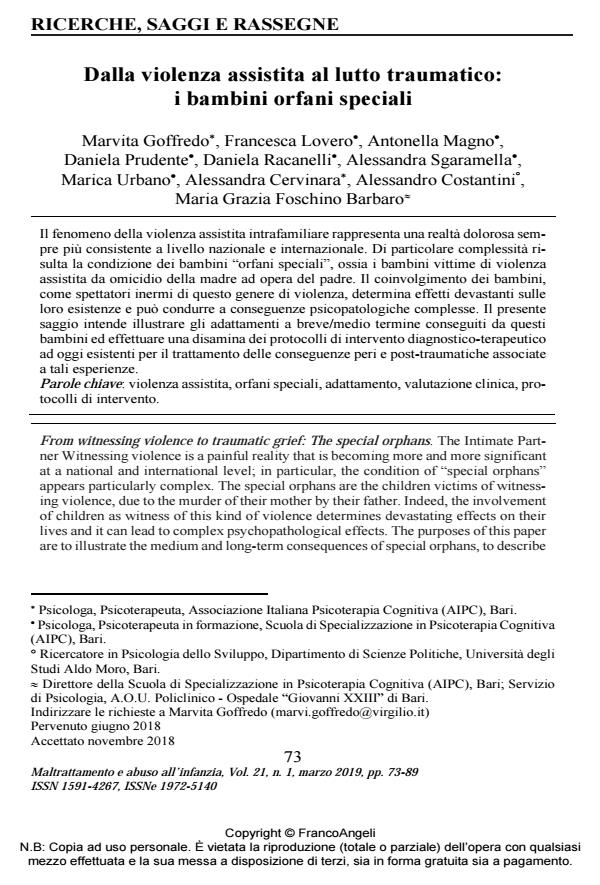From witnessing violence to traumatic grief: The special orphans
Journal title MALTRATTAMENTO E ABUSO ALL’INFANZIA
Author/s Marvita Goffredo, Francesca Lovero, Antonella Magno, Daniela Prudente, Daniela Racanelli, Alessandra Sgaramella, Marica Urbano, Alessandra Cervinara, Alessandro Costantini, Maria Grazia Foschino Barbaro
Publishing Year 2019 Issue 2019/1
Language Italian Pages 17 P. 73-89 File size 303 KB
DOI 10.3280/MAL2019-001006
DOI is like a bar code for intellectual property: to have more infomation
click here
Below, you can see the article first page
If you want to buy this article in PDF format, you can do it, following the instructions to buy download credits

FrancoAngeli is member of Publishers International Linking Association, Inc (PILA), a not-for-profit association which run the CrossRef service enabling links to and from online scholarly content.
The Intimate Part-ner Witnessing violence is a painful reality that is becoming more and more significant at a national and international level; in particular, the condition of "special orphans" ap-pears particularly complex. The special orphans are the children victims of witnessing violence, due to the murder of their mother by their father. Indeed, the involvement of children as witness of this kind of violence determines devastating effects on their lives and it can lead to complex psychopathological effects. The purposes of this paper are to illustrate the medium and long-term consequences of special orphans, to describe the assessment tools aimed to the clinical evaluation, and to define specific intervention protocols, for treating the peri and post-traumatic consequences of these experiences.
Keywords: Intimate Partner Witnessing violence, special orphan, child adjustment, as-sessment, intervention.
- Consecuencias del feminicidio en violencia machista. Análisis de necesidades de hijos, hijas y familiares en Cataluña Eva Zafra Aparici, Claudia Maria Anleu Hernández, Ma. Victòria Forns i Fernández, in Ciencia, Técnica y Mainstreaming Social /2020 pp.83
DOI: 10.4995/citecma.2020.13410
Marvita Goffredo, Francesca Lovero, Antonella Magno, Daniela Prudente, Daniela Racanelli, Alessandra Sgaramella, Marica Urbano, Alessandra Cervinara, Alessandro Costantini, Maria Grazia Foschino Barbaro, Dalla violenza assistita al lutto traumatico: i bambini orfani speciali in "MALTRATTAMENTO E ABUSO ALL’INFANZIA" 1/2019, pp 73-89, DOI: 10.3280/MAL2019-001006